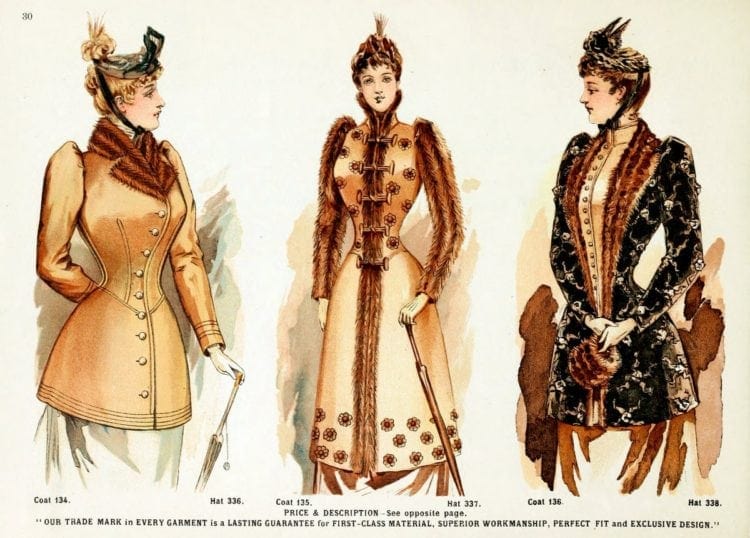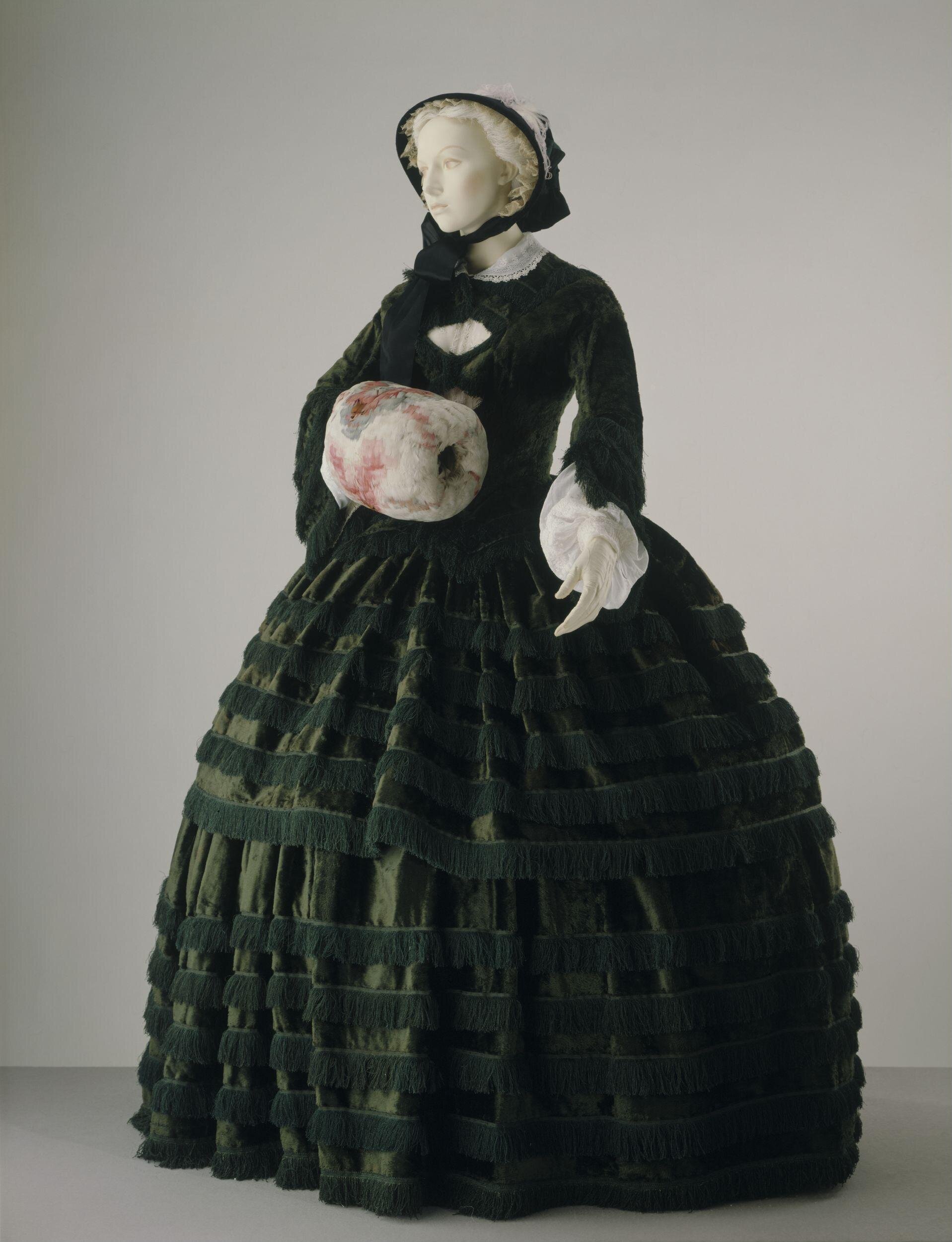There is no denying that winter is here. For the past year and a half I have lived in Denver, Colorado and I am still learning about how to dress for the chilly months and I’m enjoying it more than I thought I would. I was raised in Arizona and before moving to Denver had spent five years in Melbourne, Australia, so dressing for winter isn’t exactly second nature to me. I am in the process of shopping for another coat, and as a history writer it got me thinking about winter coats through time and how they have evolved. I have done a TON of digging around and have been surprised both at how much women’s coats and winter wear have changed from decade to decade, and also how much digging I have had to do on this particular topic. I guess it’s not as fun for dress historians to cover as are corsets or Dior. But I am enjoying the search and today will cover 100 years of winter coats, from 1880 to 1980. If readers enjoy it I will do another post later in the season on earlier times.
So bundle up, and take a look into winter coats through time with me!
Winter coats through time: 1880-1980
1880-1900:
The skirts of the late 1880s were still outrageously wide and high, with the bustle making a comeback around 1883. The bodice and sleeves were fitted, and the tailored coat was the look of the decade. They were absolutely lovely, with the intricate hand-sewn detail of the time.

This was also the height of the use of animal skins for clothing and the most popular materials for the body of the coats were seal and lamb wool, though velvet was also used. Said The Cinncinati Enquirer in 1891:
“This winter, sealskin will be more expensive than ever, and, in consequence, will be considered the most stylish fur. That and sable will be the most worn, and will even be combined in the same garment.”
1900-early 1910s:
The tailor-made coat remained the standard for the beginning part of the 20th century. A 1910 Salt Lake Tribune style article says it best:
“The cult of the tailor-made suit has increased by leaps and bounds this past few seasons. There is nothing more suited to our climate than the cloth and coat skirt. In America, we women have combined to perfection – the mannish English line and the softly feminine French line to produce a pleasing curved silhouette for the coming dress fashions of 1911. As for the textiles – Irish, Scots and English homespun, tweed mixtures from Paris, and lush velvets – all vie for first place. Dark shades predominate!”
“The ideal protection for those chilly autumn days is still fur. No woman would feel complete and feminine without one. This season’s skins come in a wide variety to suit every woman’s purse. Sable, seal, mink, lynx, fox and black marten are the favorite furs, while for smart occasions – ermine is essential. The Parisian fad of combining fur with chiffon and lace is indeed a very pretty one, and for evening or early winter wear it is much used in coats.”
Late 1910s-1920s:
The “cult” of the tailored coat finally came to an end in the late 1910s, as the winter coat left the female form and expanded to create a much looser fit to go along with the increasingly “shapeless” styles of the time. The image below is a classic example.

“Fur collars and cuffs defined coats of the Jazz Age,” says Glamour Magazine in their cute video “How Winter Coats Have Changed From the 1920s to Now.” While the cut of winter coats remained loose, there was more of an emphasis on glamour and decadence. This created a look that was in stark contrast to many of the straight, sleek fashions as it seems to be that when it came to coats the rule was “bigger is better.”

I think this might be my favorite period for winter coats.
1930s-1940s:
Winter coats evolved quickly in the 20th century. While the coats of the 1920s were big, luxurious, and made for a woman to get lost in, Dior’s “new look” brought back the focus on the waist, with coats becoming cinched at the beginning of the 1930s and the cut becoming more defined through the 1940s. There was also a focus on the bust, also likely as a result of the hourglass focus of women’s dresses.

Fur remained popular, but the trimmings were much more understated. We even see a comeback of the muff in the 1930s, but I will save that for another post!
1950s:
The 1950s is one of my favorite fashion periods, and it was a fun one for coats. You may be familiar with the look: very boxy, big buttons, velvets, felts, twills, and small fur trims. According to the same Glamour article I mentioned above, the big, boxy style partially caught on as the coats could be used for maternity coats during the baby boom! This is a humorous example of function informing fashion! This could make sense, however, as the boxy cut of coats does not at all correspond to the tight bodice and flared skirt fashions of the time that I adore so much.

Mid 1960s-1970s:
The coat theme of the 60s and 70s was “let’s have some fun with it!” I think that these decades were really the beginning of winter fashions simply becoming less prescribed and saw people wearing just what they liked rather than what was the popular look. That being said, in general, coats did shrink from what we saw in the 1950s.

The late 1960s and 1970s saw the emergence of the leather coat, sometimes with fur trim, which is now considered an iconic look from the time. Other trends were the wrap coat, muted tones, chunky patterns, and animal prints.

1980s:
I thought that the 1980s would be an appropriate decade to end with when I came across a Mashable article referring to it as the “Golden Age” of winter coats. And I can understand why; there was an explosion of different styles and designers and individuals alike were out to be bold and modern and that is reflected in the diversity.

A few trends included the mini trench coat, bright ski jackets and windbreakers, sharply defined shoulder pads, stonewashed denim, rhinestones, airbrushed prints, and leather bomber jackets. Fun!
Faux fur was now the trend, as thankfully people started to become more conscious about animal rights.

It really seems like the emphasis was on creativity more than anything else, and it is so much fun to look back at now.
What is your favorite winter look from the past?














Very nice blog! informative and interesting. keep posting.
I am so glad you enjoyed it – thanks for reading!
Your blog features have been great! Your supporting samples are period coats are perfect. I recognize many of my 1950’s 4-H projects! As a fellow Colorado transplant, you will want to sort spelling chili from chilly! Just saying……!